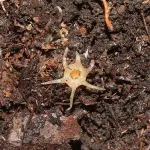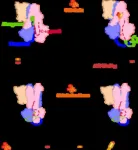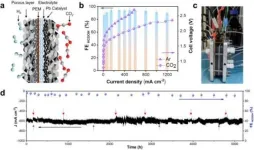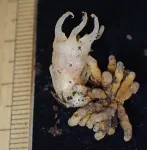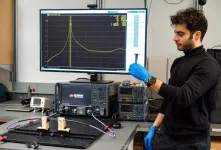(Press-News.org)
An international team of astronomers — including Clemson University astrophysicist Dieter Hartmann — obtained observational evidence for the creation of rare heavy elements in the aftermath of a cataclysmic explosion triggered by the merger of two neutron stars.
The massive explosion unleashed a gamma-ray burst, GRB230307A, the second brightest in 50 years of observations and about 1,000 times brighter than a typical gamma-ray burst. GRB230307A was first detected by NASA’s Fermi Gamma-Ray Space Telescope on March 7, 2023.
Using multiple space- and ground-based telescopes, including NASA’s James Webb Space Telescope, the largest and most powerful telescope ever launched into space, scientists were able to pinpoint the source of the gamma-ray burst in the sky and track how its brightness changed.
With the information gathered, the researchers determined the burst was the result of two neutron stars that merged in a galaxy 1 billion light-years from Earth to form a kilonova. The researchers observed evidence of tellurium, one of the rarest elements on Earth.
The breakthrough discovery puts astronomers one step closer to solving the mystery of the origin of elements that are heavier than iron.
“I’m a high energy astrophysicist. I like explosions. I like the gamma rays that come from them. But I’m also an astronomer who really cares about fundamental questions like how did heavy elements form,” Hartmann said.
Gamma-ray bursts (GRBs) are bursts of gamma-ray light — the most energetic form of light — that last anywhere from seconds to minutes. The first GRBs were detected in the 1960s by satellites built to monitor nuclear testing.
GRBs have different causes.
Long duration GRBs are caused by supernovas, the point when a massive star reaches the end of its life and explodes into a burst of light. Short duration GRBs are caused by the merger of two neutron stars, known as a kilonova, or the merger of a neutron star and a black hole.
Although GRB230307A lasted for 200 seconds, scientists saw the afterglow color change from blue to red, a signature of kilonova.
“The burst itself actually indicated a long duration event, and it should have been a normal supernova-type situation. But it had unusual features. It didn’t quite fit the patterns of long bursts,” Hartmann said. “It turns out that this radioactive cloud, that kilonova afterglow, which had all these nuclear synthetic fingerprints in it, is the signature of a binary merger. The excitement comes from using the Webb to identify a chemical fingerprint that we had expected for short bursts and seeing it inside a long burst.”
Hartmann said the Big Bang produced hydrogen and helium. All other elements were made by stars and processes in the interstellar medium.
“Some of them are massive enough to explode and they return that material to their gaseous environments which later make new stars. So, there’s a cycle in the universe that makes us more enriched in carbon, nitrogen, oxygen, all the things we need,” he said. “We call stars the cauldrons of the universe.”
Thermonuclear reactions, or fusion, make stars shine. That leads successively to the production of more heavy elements, Hartmann said. But when it gets to iron, there isn’t much energy left to squeeze out, he said.
So, where do all the heavy elements such as gold and uranium come from?
“The heavy elements have special origins. There are two processes that dominate. One is called rapid; the other is called slow. We believe the r-process happens in those neutron star mergers,” Hartmann said.
Theoretical modeling suggested kilonovas should produce tellurium, but the detection of a spectral line by the James Webb Space Telescope provided experimental evidence. A spectral line is a dark or bright line within a continuous spectrum. It is produced by transitions within atoms or ions.
“We think it’s a pretty secure identification, but it’s not beyond a reasonable doubt like they would say in court,” Hartmann said.
Detailed findings from the research can be found in the paper titled “Heavy element production in a compact object merger observed by JWST” that appeared in the scientific journal Nature.
In addition to Hartmann, researchers from several universities in the United States as well as scientists from the Netherlands, the United Kingdom, Italy, Japan, Denmark, Spain, Sweden, Australia, Ireland, France, New Zealand, Canada, Israel, Iceland, Czech Republic and Germany were involved.
END
The metabolic process of bilirubin has been a focus in medical research since the abnormal accumulation of bilirubin has been found to be associated with a variety of diseases. Bilirubin is a substance produced by the breakdown of aging or damaged red blood cells, and its effective removal is essential for human health.
A research team led by Prof. CHEN Yuxing and Prof. ZHOU Congzhao from the University of Science and Technology of China (USTC) of the Chinese Academy of Sciences has revealed the three-dimensional structure and working mechanism of the human bilirubin transporter ABCC2. The study was published ...
The metabolic process of bilirubin has been a focus in medical research since the abnormal accumulation of bilirubin has been found to be associated with a variety of diseases. Bilirubin is a substance produced by the breakdown of aging or damaged red blood cells, and its effective removal is essential for human health.
A research team led by Prof. CHEN Yuxing and Prof. ZHOU Congzhao from the University of Science and Technology of China (USTC) of the Chinese Academy of Sciences has revealed ...
A new species and genus of fairy lantern, tiny glass-like white plants that feed on fungi, has been discovered in Japan. In the country renowned for its extensive flora research, the discovery of a new plant genus is extremely rare and has not occurred in almost 100 years.
Fairy lanterns, or Thismiaceae as they are known to botany, are very unusual plants found mainly in tropical but also in subtropical and temperate regions. First of all, they are not green and do not engage in photosynthesis, but rather feed on fungal mycelia in the ground. As a consequence, they are often hidden under fallen leaves and only for a brief period produce above-ground flowers that look like glasswork. The ...
PHOENIX, February 29, 2024 — Research on patient-centered treatment of head and neck cancers will be presented at the 2024 Multidisciplinary Head and Neck Cancers Symposium, which takes place in Phoenix and online today through March 2. Media registration is available via our press kit, and general registration is available via the meeting website.
Seven high-impact studies recommended by symposium leadership for media are noted below. All abstracts are available online. Experts are available to provide outside commentary and perspective on research at the meeting; ...
Over the past two decades, the immune system has attracted increasing attention for its role in fighting cancer. As researchers have learned more and more about the cancer-immune system interplay, several antitumor immunotherapies have become FDA-approved and are now regularly used to treat multiple cancer types.
Yet despite these advances, much remains unknown about how the immune system fights cancer — and about immunity in general, said Martin LaFleur, a postdoctoral fellow in the laboratory of Arlene ...
In a first-of-its-kind development, UBC Okanagan researchers, in collaboration with Drexel University, have created a new compound that can be used to 3D print telecommunication antennas and other connectivity devices.
These 3D printed products, created by combining a two-dimensional compound called MXenes with a polymer, can be used as an alternative for metallic counterparts and can make a vast improvement in communication technology including elements such as antennas, waveguides and filters.
Waveguides are everywhere, yet most people don’t know what they are, says Dr. Mohammad Zarifi, a researcher in UBC Okanagan’s Microelectronics and Gigahertz ...
An estimated 4 to 8 million older adults with mild cognitive impairment are currently driving in the United States, and one-third of them will develop dementia within five years. Individuals with progressive dementias are eventually unable to drive safely, yet many remain unaware of their cognitive decline.
Currently, screening and evaluation services for driving can only test a small number of individuals with cognitive concerns, missing many who need to know if they require treatment.
Nursing, engineering and neuropsychology researchers at Florida Atlantic University are testing and evaluating a readily and rapidly available, unobtrusive in-vehicle sensing ...
(LOS ANGELES) – February 29, 2024 - The Terasaki Institute for Biomedical Innovation (TIBI) is pleased to announce their selection of Professor Nicholas A. Peppas of The University of Texas at Austin as the recipient of the 2024 Paul Terasaki Distinguished Scientist Innovation Award. The award will be presented at TIBI’s 2nd annual Terasaki Innovation Summit, to be held March 27-29, 2024, at the UCLA Meyer & Renee Luskin Conference Center.
The award was created in memory of Dr. Paul I. Terasaki, a pioneer in organ transplant research and innovation. It recognizes outstanding achievement in the field of biomedical ...
(LOS ANGELES) – February 29, 2024 - The Terasaki Institute for Biomedical Innovation (TIBI) is pleased to announce their selections of Assistant Professors Amir Manbachi of Johns Hopkins University and Ritu Raman of the Massachusetts Institute of Technology (MIT) as the recipients of the 2024 Hisako Terasaki Young Innovator Awards. The awards will be presented at TIBI’s 2nd annual Terasaki Innovation Summit, to be held March 27-29, 2024, at the UCLA Meyer & Renee Luskin Conference Center.
The award was created in memory of Hisako Terasaki, philanthropist, accomplished artist, and wife ...
The latest Canada’s Food Guide presents a paradigm shift in nutrition advice, nixing traditional food groups, including meat and dairy, and stressing the importance of plant-based proteins. Yet, the full implications of replacing animal with plant protein foods in Canadians’ diets are unknown.
New research at McGill University in collaboration with the London School of Hygiene & Tropical Medicine provides compelling evidence that partially substituting animal with plant protein foods can increase life expectancy and decrease greenhouse gas emissions. Importantly, ...


